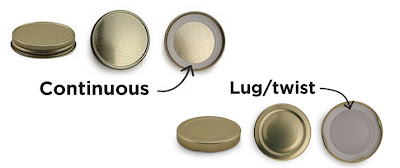The Plastisol Saga: The debate finally reaches a resolution


Plastisol closures are the hottest topic to ever hit the CPS blog. Flashy subject matter like QR codes and how-to guides on finding the perfect packaging combo (bottle, closure, color) have floundered in comparison to plastisol or any home-canning related posts. With so much interest and conversation, it seems only appropriate to offer a more in-depth look at plastisol closures.
A quick refresher
For the newbies in the crowd, plastisol closures are metal lids lined with PVC along the perimeter. These closures can be matched with glass jars to create a tamper-evident, vacuum seal. The process occurs as the solid plastisol material is melted (through heat transference from the product in the glass jar, no lid pre-heating necessary) and eventually cools along the landing of the glass jar, in turn creating the vacuum seal.
Real world application
Meet Canning Carl. He’s ready to make some of his world famous (at least that’s what his mom says) strawberry jam. Previous canning posts explain the two canning methods, boiling water canning (recommended processing for high-acid food) and pressure canning (recommended processing for low-acid food). Strawberries and most other fruit are high-acid products. This means Carl should process his jam via the boiling water method. Though this isn’t his first canning rodeo, he’s never matched his glass jars with plastisol closures before. Where should he start? We’ll catch up with Carl later.
To boiling water bath, or not to boiling water bath?
An extensive discussion took place in the comments of our previous post on plastisol regarding the exact use of these lids. We know they’re meant to form a seal with glass jars, but under what conditions? Are plastisol closures designed to be used in both boiling water canning and pressure canning processes? Maybe it’s an either or situation, or maybe they aren’t suitable for any type of processing. Whatever the definitive answer is, it’s about time we get to the bottom of this issue.
An expert opinion
You don’t have to be a thermodynamics physicist to consider the basics. A boiling water canner maintains temperatures capable of boiling water, or in other words, 212 ° F. Pressure canners maintain a much higher heat level. The question is whether or not plastisol closures are capable of functioning under these extreme temperatures.
For lack of a better answer, some are and some aren’t. Continuous thread plastisol lids have a lower heat tolerance than other plastisol's and should only be used in hot fill cases, where processing is not part of the equation. Lug/Twist plastisol lids on the other hand are fully capable of enduring boiling water temperatures up to 220° F. Any processing over this temperature, mainly pressure canning, requires a different, high heat (formerly known as a retort) liner for effective use. We don’t stock high heat lined closures but if that’s what you’re after give us a call and we’ll be happy to help you out.

The verdict
The final judgment has been revealed! Glass jars and plastisol closures can take the heat! In levels, that is.
| Heat (Process) Treatment | Minimum sealing temperature* | Maximum Process Temperature | Recommended Plastisol Type |
| Hot fill and cool | 185°F / 85°C | 185°F / 85°C | Standard |
| Cold fill and pasteurize | 68°F / 20°C | 185°F / 85°C | Pasteurization |
| Hot fill and pasteurize | 149°F / 65°C | 195°F / 90°C | Pasteurization |
| Sterilization (retort) with overriding pressure | 149°F / 65°C | 250°F / 121°C | Retort |
| * Sealing temperature is used to represent the temperature of the product in the jar after capping, and not the temperature of the product in the filler bowl. | |||
Summing it all up…
It feels good to have a resolution, doesn’t it? Canning Carl can proceed with his strawberry jam (using a Lug/Twist cap) and we all know exactly which plastisol lid–glass jar combo we need to maximize our food preserving experiences.
Still loving plastisol? Please share your experiences using plastisol closures or submit any other questions you have in the comments!